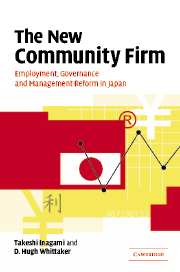Book contents
- Frontmatter
- Contents
- List of figures
- List of tables
- Preface
- Acknowledgements
- Part 1 The End of the Community Firm?
- 1 Company as Community
- 2 The Classic Model: Benchmark for Change
- 3 Change and Continuity
- 4 Company Professionals and Creative Work
- 5 Corporate Governance and Managers' Ideologies
- 6 Consolidated Management and Quasi Internal Labour Markets
- 7 Summing Up
- Part 2 Hitachi: ‘Here, the Future’
- Part 3 The Reformed Model
- Appendix: Changes in Job Tenure
- References
- Index
7 - Summing Up
Published online by Cambridge University Press: 22 September 2009
- Frontmatter
- Contents
- List of figures
- List of tables
- Preface
- Acknowledgements
- Part 1 The End of the Community Firm?
- 1 Company as Community
- 2 The Classic Model: Benchmark for Change
- 3 Change and Continuity
- 4 Company Professionals and Creative Work
- 5 Corporate Governance and Managers' Ideologies
- 6 Consolidated Management and Quasi Internal Labour Markets
- 7 Summing Up
- Part 2 Hitachi: ‘Here, the Future’
- Part 3 The Reformed Model
- Appendix: Changes in Job Tenure
- References
- Index
Summary
The origin of Japan's community firms can be traced to the interwar years, perhaps even earlier, but interwar and postwar community firms were not the same. There was a shift from managerial familism to managerial welfarism (Hazama), or welfare corporatism (Dore). Our interest is in changes since Hazama and Dore's portrayal of community firms in the late 1960s and early 1970s, and whether another fundamental shift began in the late 1990s. Are the encroachment of market forces, and social and ideological change, destroying the community characteristics?
In the final chapter of Part 1 we briefly summarize our findings so far and offer just a few preliminary conclusions, saving our main evaluation for Part 3.
Foundations of the community company
In chapter 1 we examined what has been written about the norms, behaviour and institutions of the community company, in which an implicit ‘contract’ involving an exchange of loyalty and effort for security is integrated into management priorities, and engenders a sense of membership and the development of shared norms and ‘we-consciousness’. This becomes a source of motivation, but it may also override individual interests.
In our selective review of Japanese management, we saw that for Tsuda, company-as-community was a feature of modern management, and Japanese management was simply one variation. He changed his position, however, and began to emphasize the distinctiveness of Japanese management, linked to Japan's cultural traditions. Others, too, popularized the view that community firms were a particularly Japanese phenomenon.
- Type
- Chapter
- Information
- The New Community FirmEmployment, Governance and Management Reform in Japan, pp. 103 - 110Publisher: Cambridge University PressPrint publication year: 2005



